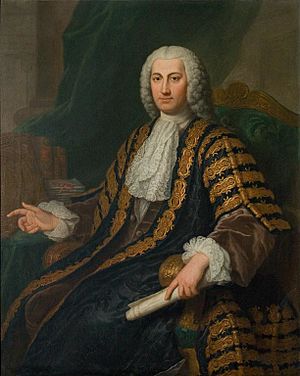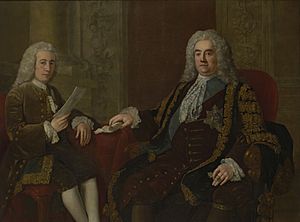Henry Bilson-Legge facts for kids
Quick facts for kids
Henry Bilson-Legge
|
|
|---|---|

Henry Bilson-Legge dressed in the robes of state for the Chancellor of the Exchequer. Portrait by William Hoare
|
|
| Chancellor of the Exchequer | |
| In office 6 April 1754 – 25 November 1755 |
|
| Monarch | George II |
| Prime Minister | The Duke of Newcastle |
| Preceded by | Sir William Lee |
| Succeeded by | Sir George Lyttelton, Bt |
| In office 16 November 1756 – 13 April 1757 |
|
| Monarch | George II |
| Prime Minister | The Duke of Devonshire |
| Preceded by | Sir George Lyttelton, Bt |
| Succeeded by | The Lord Mansfield |
| In office 2 July 1757 – 19 March 1761 |
|
| Monarch | |
| Prime Minister | The Duke of Newcastle |
| Preceded by | The Lord Mansfield |
| Succeeded by | The Viscount Barrington |
| Personal details | |
| Born | 29 May 1708 |
| Died | 23 August 1764 (aged 56) |
| Nationality | British |
| Political party | Whig |
| Spouse | Mary, Lady Stawell (later Countess of Hillsborough) |
| Alma mater | Christ Church, Oxford |
Henry Bilson-Legge (born May 29, 1708 – died August 23, 1764) was an important English politician. He is best known for serving three times as the Chancellor of the Exchequer in the 1750s and 1760s. The Chancellor of the Exchequer is like the chief financial minister for the country, managing its money.
Contents
Early Life and Education
Henry Bilson-Legge was the fourth son of William Legge, 1st Earl of Dartmouth. His mother was Lady Anne. He went to Christ Church, Oxford for his education.
His Political Journey

Henry Bilson-Legge began his career as a private secretary to Sir Robert Walpole, a very powerful politician at the time. In 1739, he became the Chief Secretary for Ireland. This role involved helping the Lord Lieutenant govern Ireland.
He also became a Member of Parliament (MP). He represented the area of East Looe in 1740. The next year, he became the MP for Orford, Suffolk.
Rising Through Government Roles
Even when Walpole's political power decreased, Legge quickly gained new important jobs. He became the Surveyor-General of Woods and Forests. This meant he looked after the country's forests. He also became a Lord of the Admiralty, helping to manage the navy. Soon after, he was a Lord of the Treasury, which involved managing government money.
In 1748, he was sent to Frederick the Great in Berlin as a special envoy. An envoy is like a diplomat or representative from one country to another. Even though King George II wasn't happy with his actions in Berlin, Legge soon became the Treasurer of the Navy.
Serving as Chancellor of the Exchequer
In April 1754, Henry Bilson-Legge joined the government of the duke of Newcastle. He took on the important role of Chancellor of the Exchequer. King George II agreed to this, even though he didn't want to talk to Legge directly.
However, Legge disagreed with the policy of paying money (subsidies) to the Landgrave of Hesse. Because of this disagreement, he was removed from his position in November 1755.
Returning to Power
Just a year later, in November 1756, he returned to his role as Chancellor of the Exchequer. This was under the government of William Pitt and the 4th Duke of Devonshire. He stayed in this job until April 1757. When he was dismissed again, he became very popular with the public, just like Pitt.
When Pitt and the Duke of Newcastle formed a new government in July, Legge became Chancellor of the Exchequer for the third time. During this time, he introduced new taxes on houses and windows. The King, however, refused to make him a peer (a member of the nobility).
Later Career and Legacy
In 1754, Henry Legge added "Bilson" to his name. This was because he inherited an estate from his cousin, Leonard Bilson.
In 1759, he received a job called "surveyor of the petty customs and subsidies in the port of London." This was a "sinecure" position, meaning it paid money but didn't require much work. Because of this, he had to give up his seat in Parliament. He was then chosen to represent Hampshire. This made the Earl of Bute very angry, as Bute wanted that seat for one of his friends.
Because he angered Bute, Legge was again dismissed from his role as Chancellor in March 1761. He continued to speak in Parliament until he passed away in Tunbridge Wells in 1764.
William Pitt called Legge "the child, and deservedly the favourite child, of the Whigs." This meant he was seen as a key and popular figure among the Whig political group. Horace Walpole, another famous figure, first described Legge as sneaky. However, Walpole later spoke highly of Legge's talents.
People generally believed he was a very capable person. He was seen as a skilled statesman and a good manager of money. He held many important government jobs with a good reputation and honesty.
Family Life
Henry Bilson-Legge married Mary Stawell. She was the daughter of Edward Stawell, 4th Baron Stawell. In 1760, Mary was given the title of 1st Baroness Stawell.
Henry and Mary had one child, a son also named Henry (born 1757 – died 1820). When his mother died in 1780, he became the 2nd Baron Stawell. However, when the 2nd Baron Stawell died without any sons, the title of Baron Stawell ended. His only daughter, Mary, later married John Dutton, 2nd Baron Sherborne.

